“I believe one’s choice of brush to be a very personal thing.” – Me
Is it bad to quote myself?? Oh well. I have.
Let’s get to the first issue. You absolutely need specific brushes for watercolour painting, you cannot use any old brush lying around. Watercolour brushes are designed to work with watercolour paint and watercolour paper.
Brushes used for acrylic and oil painting will not hold the amount of water required for watercolour painting. On that note, do not use your watercolour brushes for anything other than watercolour painting!
If you use a watercolour brush with another medium (such as oil or acrylic) you will ruin the brush. Watercolour brushes are far more fragile than brushes used with other mediums, therefore a small degree of care is required to ensure they stand up to the test of time.
There’s no one size fits all answer to which brush you should use for your watercolour sketching or painting. Recommendations of which brush to try will depend on the following factors:
- Where will you be using your brush?
- What size of paper will you be using?
- Which subjects do you intend on painting?
- What’s your budget?
Firstly, let’s take a look at the different types of watercolour brushes available, what they’re used for and what they’re made from.
Watercolour Brush Types
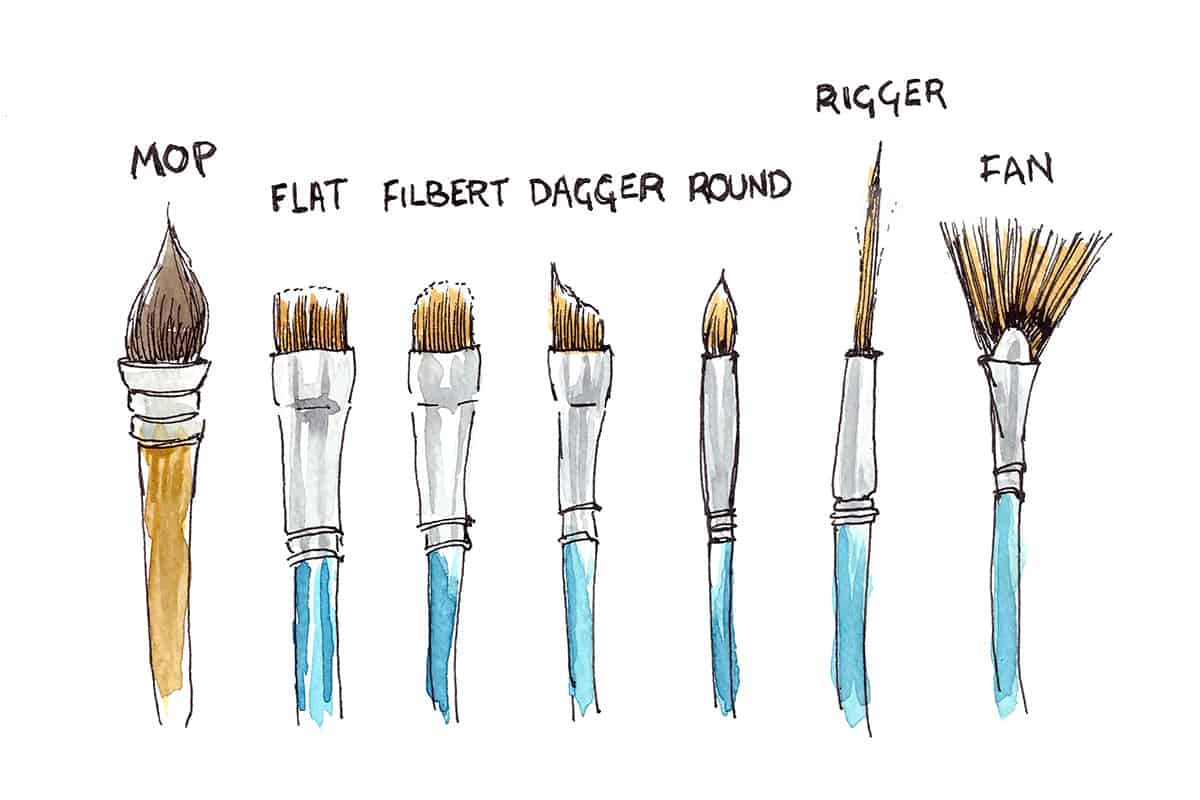
Below is a list of a few different types of watercolour brush. This is not an exhaustive list, I’m aware there are more types of brush than this, however, the context of this post is urban sketching and not full-scale watercolour painting, so let’s not get too bogged down in details that may not apply. By all means, go forth and explore the full world of watercolour brushes, but here I’d like to be as concise and relevant to you as possible.
Round
The most widely found (and used) watercolour brush is a round brush. This type of brush comes in a multitude of sizes. Use a large brush to absorb a lot of water and paint to cover a larger surface area. Use a smaller size brush for finer details.

A round brush forms a sharp point when wet which makes it excellent for finer details if you use the brush very lightly but press a bit harder and you can cover more surface area too. This makes this type of brush very versatile and one of the most widely used.
I have 3 sizes of round brush for urban sketching: size 10 for covering larger areas of paper, size 6 for covering medium-sized areas, or larger areas when working in an A5 sketchbook and a size 2 for the finer details of a sketch.
Flat
Flat watercolour brushes, as the name suggests, are flat in shape usually with a square end. Although sometimes the end of the brush is cut at an angle (which is called an angled brush). Sometimes the brush is rounded off at the very edges, this is called a Filbert.

These brushes can be used to create flat washes or paint straight lines or edges. Again, they come in a variety of sizes and the same concept applies: use a big brush size to cover larger areas and small brushes for the finer details.
Flat brushes are great for painting straight strokes, for example, use the straight-edged tips of the hairs to create repeating lines for fence posts. This type of brush is also great for painting angular objects or getting a wash to end in a straight line flush with an object such as the wall of a house.
I like to use a flat brush to paint the sky sometimes, and they’re super handy for painting the horizon line, where the sky meets the sea for example.
Mop
A Mop brush holds a very large amount of water. The bristles are very soft. This type of brush is ideal for painting a very lush wash of colour. Mop brushes tend to be made from animal hair, such as squirrel.

I tend to work in A5-sized sketchbooks when I am urban sketching. I also don’t like having to wait too long for my paint to dry (it gets boring) so I don’t use a mop brush as I just don’t need it. However, if you like working much larger and/or you are painting at home perhaps a mop brush may be useful to you.
Dagger
I bought a dagger brush after seeing Liz Steel using one a countless amount of times. She raves about her Rosemary & Co dagger brush – I believe it’s her “go-to” brush. I can see why. It feels like a few brushes in one. It’s a flat brush, cut at an angle but with a super long fine point on one end. It’s great for cutting into awkward spots and that long fine tip makes detail work a breeze.

I recently bought a “normal” handle Rosemary & Co dagger brush but they also make a travel brush version so I bought that one too and I use it a lot.
Rigger
The rigger brush can look strange and unwieldy at first glance. It has the appearance of a very long, thin round brush. Despite its appearance, the rigger brush can produce very long thin fine lines. I have only recently purchased (a cheap) one and I’m looking forward to experimenting with it. I intend to do a vide on this brush soon so look out for it on the Urban Sketching World Youtube channel.

Fan
A fan brush is not often seen too much in watercolour painting, however, after seeing some of the splattering effects Ian Sidaway achieved from a fan bristle brush in Sketchbook Skool’s Urban Sketching course I wanted to try one. I can confirm, they are excellent at splattering watercolour paint all over the place!
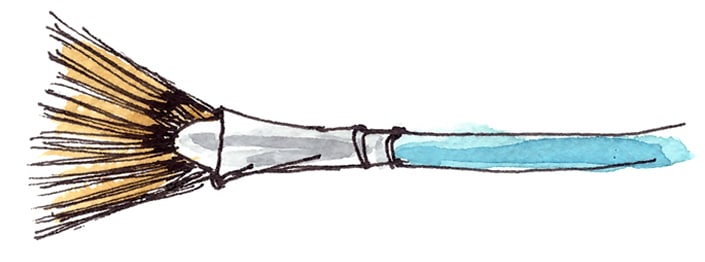
I’m not sure what else I will use the brush for but I think it would be great for textural effects such as grass or foliage. I think I will record a video using it soon so look out for it on the Youtube channel.
Brush Hair
Watercolour brushes are made from a variety of different materials. Some brushes are made from synthetic hair, some from natural hair from different sources and some are a blend. The material of the brush hair will inform the performance and the price of the brush.
Each type of brush has pros and cons. Let’s take a look at the differences.
Do you want to learn how to sketch your own adventures in ink & watercolour?
GET 50% OFF FOR A LIMITED TIME ONLY!!
I will show you my exact sketching process in ink and watercolour. I have travelled around the world in the last 3 years and this is my go-to system of creating beautiful yet quirky illustrations to capture the magic of my discoveries.
We will work through 3 projects, step by step (pictured below), all of which are real-life examples of things I have sketched along my travels. I provide the photo references you can work from.
We will start by choosing a composition, laying in the initial pencil sketch, adding ink lines, layering watercolour and adding the final touches.
This and much more are included in my course, Sketch Your Adventures, click the button under the image to find out more!
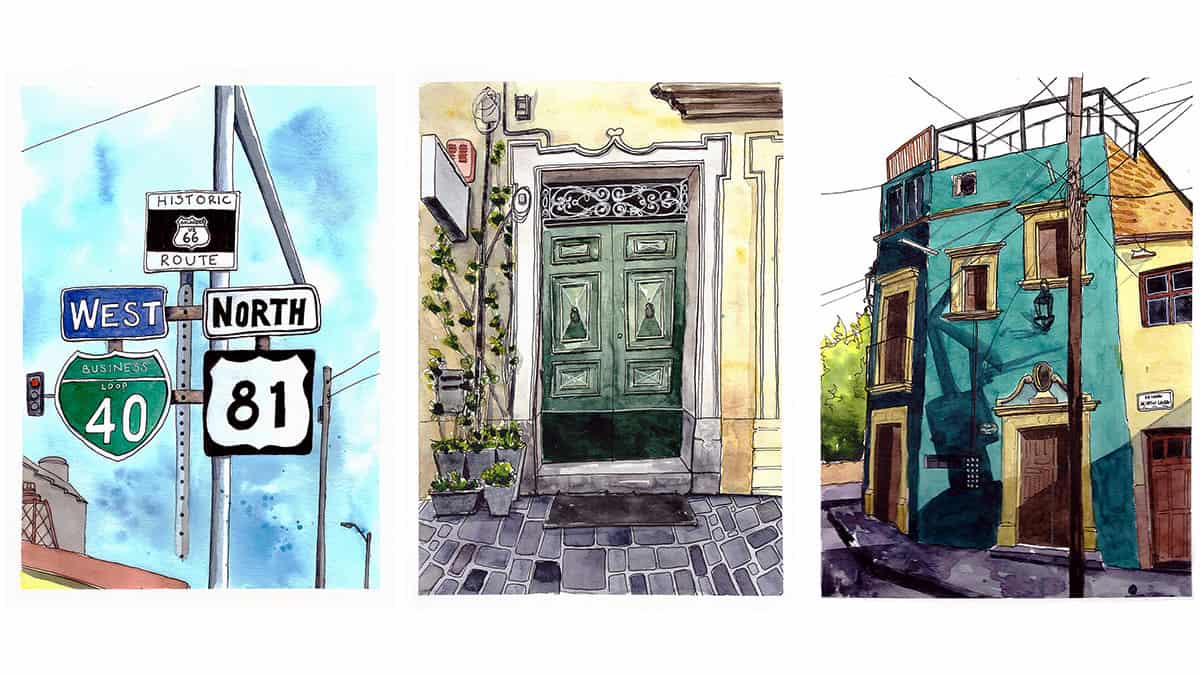
Natural
When we say natural hair, we mean the hair has been taken from an animal. Animal hair brushes have always been considered superior to brushes made with synthetic hair. However, with the advances in manufacturing techniques, modern synthetic brushes are getting better and better.
Sable hair is considered the best animal hair to make brushes from, with Kolinsky Sable considered the epitome of quality (which is of course reflected in the price). Brushes are also made from goat, squirrel or ox hair too.
Kolinsky sable hair generally comes from a Siberian weasel which is hunted for its fur. Its tail hair is used to make brushes. This is a major reason why some artists veer away from brushes made from animal hair. At some level, the purchase of such brushes is endorsing the hunting of these animals. I am not here to preach and I do own a couple of natural hair brushes, I will think twice about buying any more in future though. Go your own way – this is totally down to your own ethics.
Shedding of hair can be an issue with natural hair brushes. They are generally less hardy than synthetic brushes and more expensive. However, they have superior performance in terms of how much water they carry, as well as the ‘springiness’ of the bristles.
Synthetic Hair
Synthetic brushes have improved in quality over the years to make them a completely viable alternative to brushes made from animal hair.
Synthetic brushes are made from man-made materials such as nylon or polyester. They probably pose an environmental impact as well, although not quite so first hand as the animal hair brushes.
Synthetic brushes are not quite as soft as animal hair brushes but they are a bit more hard-wearing. They do not carry quite as much water but for us urban sketchers working in small-ish sketchbooks, it’s really not a critical issue. If you war working on a huge piece in the studio, perhaps this will become a major factor to consider.
Finally, synthetic brushes are cheaper (sometimes considerably cheaper) than natural hair brushes.
Mixture
It is also possible to buy watercolour brushes that are a blend of natural and synthetic hair. For example, Rosemary & Co have a Red Sable Blend range in which their brushes are made from a 50:50 ratio of sable and synthetic hair. They explain this offers the best of both worlds, sable to help with retaining liquid and nylon for durability. The equal ration of natural and synthetic hair means the price is more affordable than a pure sable brush too.
Brush Size
Most watercolour brushes come in a range of sizes from very large to very fine.
Sizes across brands differ, however, so a size 2 brush from one brand may not be the same size from a different brand. This can be a bit frustrating, especially if you want to buy a specific size mentioned by an artist you follow for example. Short of buying the exact brush from the brand they mention, you can’t be sure you are buying the same size.
Round brush sizes differ to the unit of measurement of flat brushes. Round brush sizes are given whole numbers, the lower the number the smaller the brush. A #1 brush will be very fine whereas a #10 will be a medium to large brush.
Flat brushes are measured in inches across the width of the ferrule (the metal bit that holds the brush to the handle). An ⅛ inch brush will be smaller and a 1-inch brush larger. Dagger brushes are measured in the same way as it’s also considered a type of flat brush.
Mop brushes do not seem to work to any sort of relative system to the previous brushes mentioned. They are also measured in whole numbers. I would suggest shopping at an art supply store for such a brush. It can be a bit tricky to shop online for such brushes.
Rigger brushes are measured from 00000, 000, 00, 0, 1, 2, 4, and 6 – 6 being the larger size. The rigger brush I bought recently is a number 1, so the middle of the pack. I didn’t buy this size for a specific reason, it was the only one in the shop and seemed a reasonable size to experiment with.
Check out my ebooks with hundreds of ink & watercolour travel sketches from all over the world. Get some inspiration for your next trip…
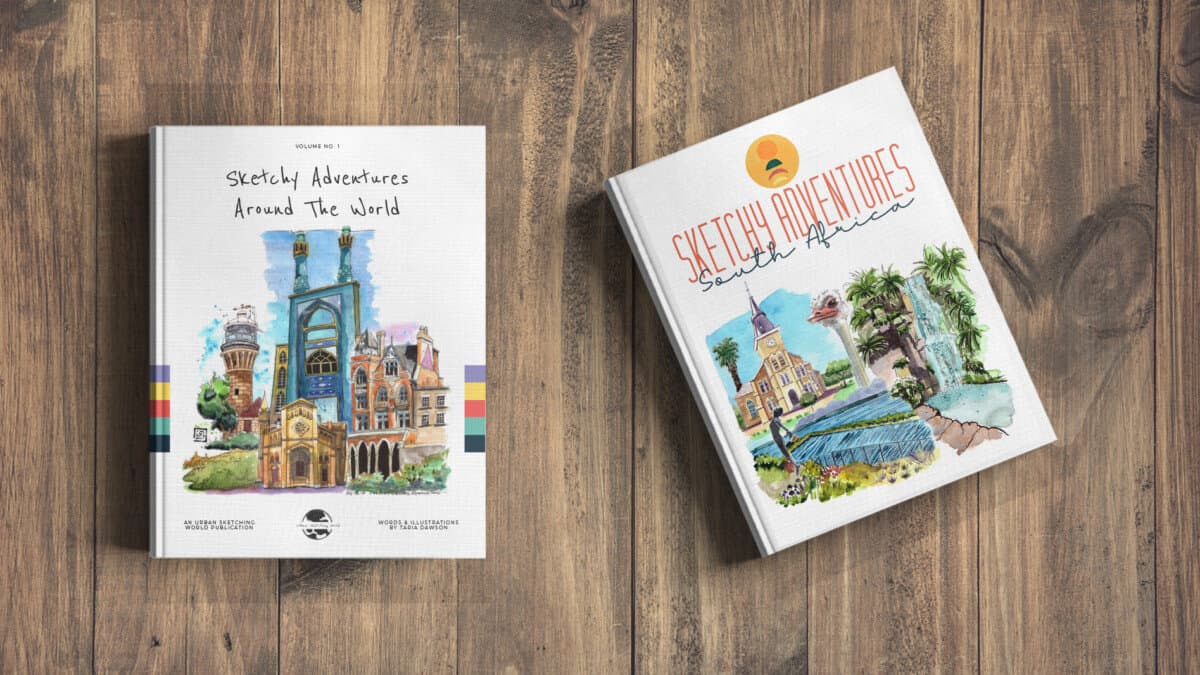
Where will you be using your brush?
Location, location, location.
If you are solely painting at home then you do not need to worry overly about how to transport your brushes without damaging them.
If you intend to do a lot of sketching on location, whether at your local park or the other side of the world, travelling without protecting your brushes sufficiently will damage them.
If you are a beginner and intend to stay at home mostly then a cheaper brush that’s not made for travel would be perfectly adequate.
What size of paper are you using?
I predominantly use an A5 sketchbook (8 x 5 inch approximately) as such a #10 round brush is plenty large enough for me to cover larger areas of my sketch with paint, for example, when I’m painting a sky.
I tend to do commissions on A4 size paper (8 x 11 inch approximately) and I find a #10 is still large enough. The other important factor is that I use a high-quality brush with natural hair. This means the brush holds a lot of water and consequently paint. This ensures I can cover larger areas of the surface without having to re-wet the brush. This is important in order to create an event wash.
Some of my favourite online classes
- Experimental Watercolour Techniques For Beginners – Ana Santos
- Watercolor Portrait Sketchbook – Carlos Rodriguez Casado
- Watercolor Travel Journal – Alicia Aradilla
- Creative Watercolour Sketching for Beginners – Laura McKendry
What subjects do you intend painting?
This could be a factor in your watercolour brush buying decisions. If you intend on painting a lot of angular subjects, such as architecture then you will definitely want to consider one or two flat brushes. If you are painting wide open landscapes or vast seascapes then you will want a brush that can hold a lot of water, such as a mop brush.
If you intend on painting a range of subjects and nothing specifically, then having a range of different-sized round brushes is a good place to start.
Which watercolour brushes should I buy?
Hopefully, this post has helped you to identify some factors to consider when buying watercolour brushes. If you are starting out then buy some synthetic brushes in a range of types and sizes. When I started I had one round brush and one flat brush. They did the job.
After that, I bought a set of water brushes, the plastic brushes that hold water in the handle. If you are starting out and just want to practice, if you are doing line and wash sketches and/or you’re travelling a lot, they really are super handy.
Consider buying the following to start off with:
- 3 round brushes: small (#2), medium (#6) and medium-large (#10) – these sizes are perfect for working in A5 / A4 size
- 1 flat brush: depending on the size of paper I would suggest a ½ inch or ¾ inch brush size
If you are at an intermediate stage and want to explore different types of brush or keen to try out natural hair brushes, consider:
- Round brushes in natural or a blend of natural and synthetic hair
- A mop brush
- Dagger brush – I highly recommend this for its versatility
If you sketch on location or travel regularly (or intend to) I would very much recommend buying travel-specific brushes, or at least a paintbrush wrap to store your brushes safely. I like travel brushes as they sit inside their own case which means the bristles are entirely protected and they have a small footprint which is great if you wish to travel lightly.
I have three Escoda Reserva round brushes (#2, #6, and #10) and a Rosemary & Co ¼ inch dagger brush that all detach in the middle so the brush end can be turned around and inserted inside the handle for safe storage. Escoda are a fantastic brand and have a range of brushes available as travel brushes, Da Vinci also makes travel-specific brushes too.
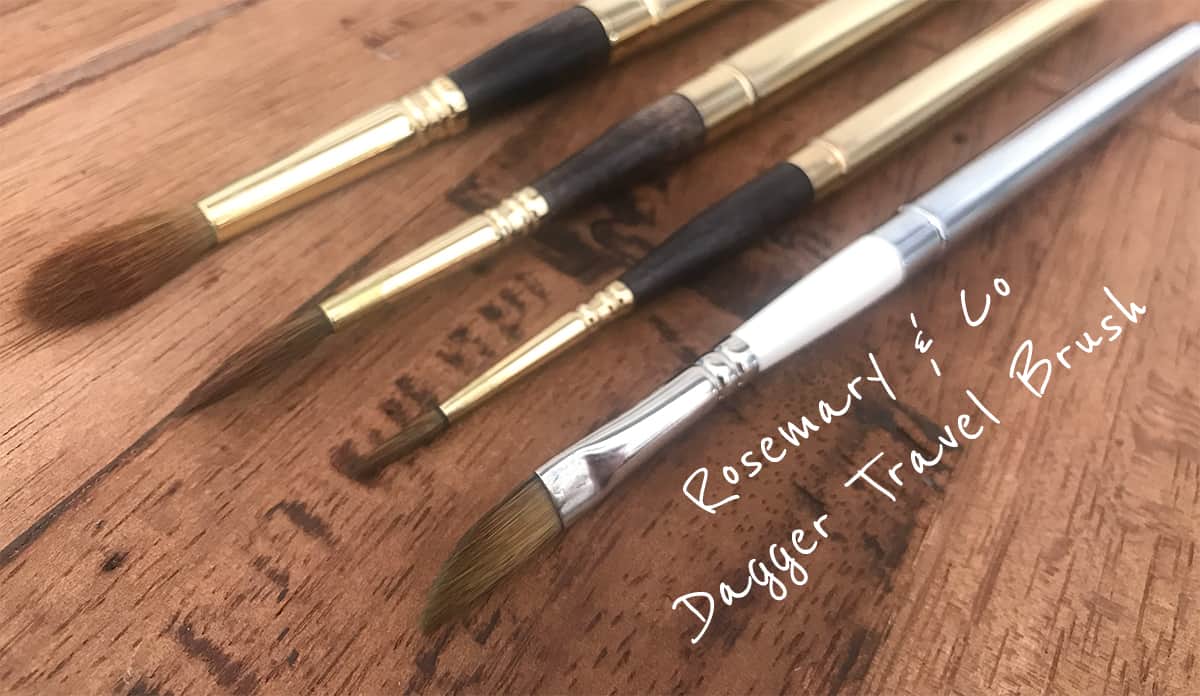
Caring for Watercolour Brushes
Do not leave your brush sitting in a jar of water! This will ruin the bristles and the shape of the brush. It may also rust the metal that holds the bristles and/or effect the glue used to keep the bristles secure.
Make sure to wash your brushes through thoroughly under the tap until the water runs clear and then place on top of a paper towel to dry. Do not leave your brushes in extreme temperatures, i.e. a very cold room or in direct sunlight. Make sure to store your brushes either lying horizontally or upright with the bristles facing upwards.
You can buy a cleaning soap for your brushes, I have never owned such a thing but if you have very expensive brushes then it may be an item you wish to consider using. Da Vinci makes a cleaning soap, I’m sure there are other brands available too.
I am going to end this post with six watercolour brush commandments (I couldn’t make it to 10, sorry):
- Thou shalt not use your watercolour brushes for other mediums (oil, acrylic, etc)
- Thou shalt not leave your watercolour brush standing in a pot of water
- Thou shalt not forget to wash your watercolour brush after painting and before storing
- Thou shalt not use your watercolour brush to apply masking fluid
- Thous shalt not throw your old watercolour brushes away (use them for masking fluid)!
- Thou shalt not leave your watercolour brush in very cold or very hot temperatures.
